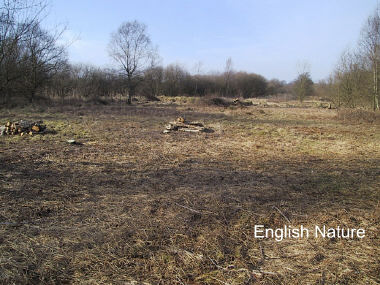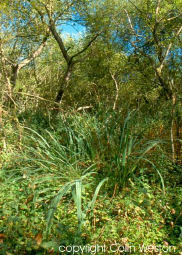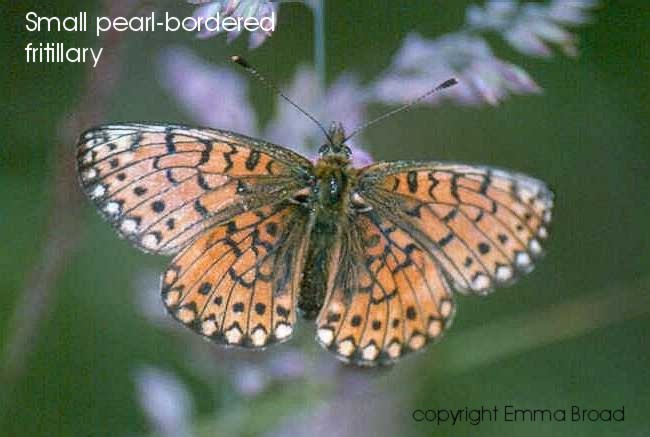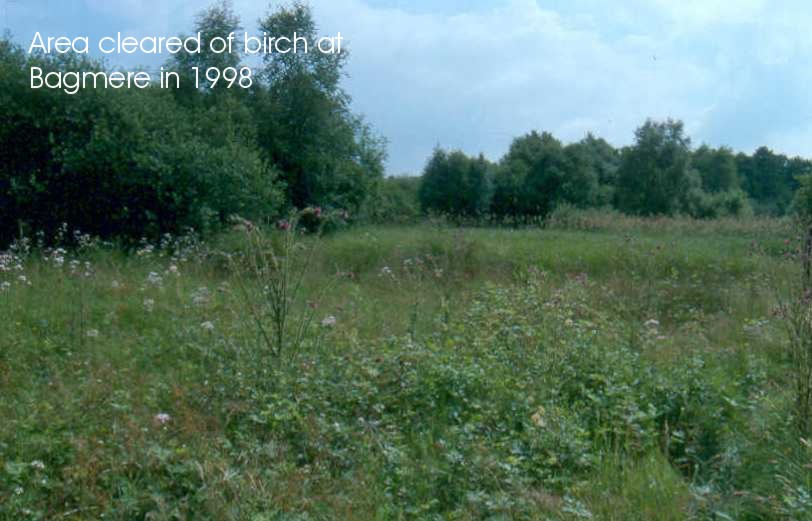FENS
LOCAL BIODIVERSITY ACTION PLAN
 Links to associated HAPs and SAPs
Links to associated HAPs and SAPs
Small pearl-bordered fritillary, Floodplain and grazing marsh, Reedbeds
Current Status
Fens are peatlands that receive water and nutrients from the soil, rock and ground water as well as from rainfall: they are minerotrophic. Fens are dynamic semi-natural systems requiring appropriate management in order to maintain the open fen communities and associated species richness. Two main types of fen occur: Topogenous fens where water movement in the peat or soil is generally vertical (e.g. basin fens and floodplain fens) and Soligenous fens where water movements are lateral (e.g. mires associated with springs, rills and flushes and valley mires). Fens can also be described as poor fens and rich fens dependent on the chemical properties of the water that feeds them.
In the Cheshire region fens are often found in a complex of habitat types associated with the meres and mosses as part of the hydrosere succession, e.g. at Hatchmere or as fen woodland or fen pasture. Petty Pool valley SSSI contains an extensive mosaic of poor and rich fen and is considered as the best example of these communties in Cheshire. Locally rare species are often associated with fens, such as tufted sedge (Carex elata) at Chapel Mere and the small pearl-bordered fritillary (Bolaria selene) at Bagmere.
A national BAP for fens is included in the UK Biodiversity Steering Group report HMSO (1995). Roger Meade (Natural England) is the co-ordinator for the UK Fens BAP.
 Threats
Threats
-
Lack of understanding of this habitat within the region.
-
Drainage and conversion to intensive agriculture.
-
Excessive water abstraction.
-
Habitat fragmentation and isolation.
-
Lack of/or inappropriate management leading to drying up, scrub encroachment, succession to woodland.
-
Agricultural run off.
-
Pollution of freshwater supplies to fens.
-
Eutrophication leading to alteration in plant communities.
-
Afforestation.
-
Inappropriate development.
-
Pond creation.
How are we helping to conserve Fens in the Cheshire region?
-
Bagmere SSSI, Betley Mere SSSI (part in Cheshire), Flaxmere Moss SSSI, Quoisley Meres SSSI, Hatchmere SSSI and Wybunbury Moss SSSI are included within the Midlands Meres and Mosses (phase 1) Ramsar Site, designated on 9 May 1994.
-
Abbots Moss SSSI, Chapel Mere SSSI, Oakhanger Moss SSSI, Linmer Moss SSSI and Oakmere SSSI are included in the Midlands Meres and Mosses (phase 2) Ramsar Site, designated on 2 February 1997.
-
Abbots Moss SSSI, Oakmere SSSI and Wybunbury Moss SSSI are submitted as candidate Special Areas for Conservation under the EC Conservation (Natural Habitats) Regulations 1994.
-
Aggregates Levy funded project to carry out baseline survey and prepare restoration plans for the meres and mosses sites in Delamere Forest.
-
EN provides advice to landowners on appropriate management, rehabilitation, extension and creation of all fen habitats.
-
EN/EA-led bid to the NW ERVNE Project for strategic study of wetland sites.
-
CWT, EN monitor key fen species on non-statutory and statutory fen sites.
-
Management Plan being prepared for Hatchmere.
-
EN Natural Area Profiles include fens as key habitats and identify issues relating to this habitat.
-
Objectives, Targets and Actions
OBJECTIVES |
LOCAL TARGETS |
1. Identify priority fen sites in need of rehabilitation.
2. Initiate restoration programme for these sites.
3. Identify appropriate water quantity and quality requirements for these sites, and ensure that these requirements are being met. |
1. Identify priority fen sites by the year 2005. All rich fen and other sites with rare communities should be considered.
2. Initiate restoration programme for these sites by 2005.
3. Ensure appropriate water quality and water quantity for the continued existence of all SSSI/ASSI fens by 2005 |
ACTIONS REQUIRED |
-
Establish link with Lowland Raised Bog Action Plan and reconvene Peatlands BAP Action Group.
-
Produce a register of all fen sites within the region and prioritise sites in need of survey, rehabilitation and expansion.
-
Extend the Meres and Mosses Strategy investigations to include non-statutory sites and ensure that investigations take into consideration fen requirements.
-
Continue to notify important sites as SSSIs and SBIs.
-
Promote the uptake of Agri-environment Schemes to conserve, restore and enhance fens
-
Ensure appropriate water quality and quantity for the continued existence of all fen sites.
-
Include issues relating to fen protection, management and creation in all EA LEAPs.
-
Produce water level management plans to safeguard sensitive sites under the Urban Waste Water Treatment Directive.
-
Identify fens within Nitrate Vulnerable Zones.
-
Ensure appropriate management of existing fen sites is carried out.
-
Ensure that development schemes do not affect the integrity and conservation interest of fens.
-
Discourage forestry on areas of fen.
-
-
Promote the interchange of management techniques.
|
Progress so far
| 2004 Action Completed |
-
Aggregates Levy funded project to carry out baseline survey and prepare restoration plans for the meres and the mosses in the Delamere Forest compeleted in 2004.
-
Phase 1 of the North West Wetlands Network Project, funded by English Nature, Environment Agency and North West Development Agency, to identify the socio-economic value of wetlands in the North West completed in 2004. Funding for Phases 2 and 3 now secured for 2005.
-
Management plan prepared for Hatchmere by CWT in 2004.
-
At Bagmere work to restore areas of fen for the small pearl-bordered frittillary, a BAP species continued in 2004 and plans to re-introduce grazing are at an advanced stage.
-
Fen restoration work ongoing in 2004 at Hatchmere, Pettypool Brook Valley and Chapel Mere.
|
| 2003 Action Completed |
-
EA hydrological study of Oak Mere and Abbotts Moss in 2003
-
NVC Vegetation Survey completed for all Mere and Moss SSSIs.
-
Management works at Oakmere, The Mere, Oakhanger Moss, Bag mere, Pettypool Brook Valley and Tatton Meres in 2003
-
Meres and Mosses Forum meeting held 1 July 2003.
|
| 1997 - 2003 Action Completed |
-
EA/EN/RSPB "Lowland Wetland Project" completed
-
EN/EA funded ECUS reports for all SSSI Meres and Mosses completed, includes areas of fen.
-
CWT purchased Hatchmere in 1999.
-
First draft of fens database produced.
-
EN Pilot Project "England Inventory for the Wetland Habitat Action Plan" has been completed which included Cheshire. The project produced a geospatial database on CD, which includes metadata on the occurrence of fens, reedbeds and lowland raised bog in the pilot area, a GIS database of habitat maps, and links to existing (mainly non-spatial) databases. 147 Cheshire sites included.
|
How to find out more about Fens
UK BAP for Fens - www.ukbap.org.uk/UKPlans.aspx?ID=18
Contact details
| LBAP Chair |
Mandy North, Natural England
Phone: 01942 820342 |
| National Lead Partner |
Natural England
|
| National Contacts |
Roger Meade, Natural England
Phone: 01733 455565
Rebecca Longfield, Faber Maunsell
Phone: 01733 391456 |
References & Glossary
English Nature (1993): Midland Meres and Mosses RAMSAR Citation.
HMSO (1995): Biodiversity: The UK Steering Group Report, Volume 2:Action Plans, London.
JNCC (1997): The Habitats Directive: selection of Special Areas of Conservation in the UK. JNCC Report No. 270.
English Nature (1998): Natural Area Profile, Meres and Mosses 27.
English Nature (1998): Natural Area Profile, Dark Peak.
English Nature (1998): Natural Area Profile, South West Peak.
English Nature (1998): Natural Area Profile, Urban Mersey Basin.
English Nature (1998):A Strategy for the conservation of the Meres and Mosses of Cheshire, Shropshire and Staffordshire.
English Nature (1999): Natural Areas in the North West Region, helping set the regional agenda for nature.


 Links to associated HAPs and SAPs
Links to associated HAPs and SAPs  Threats
Threats 
